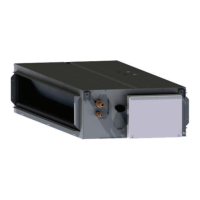Item SEG2 SEG1 SET
10
Indoor expansion valve control
target value for cooling
SC O
11
Indoor expansion valve control
target value for heating
SH O
12
Indoor expansion valve opening
during heating operation stoppage
Si O
13
Indoor expansion valve opening
during heating thermo-off
So O
14
Indoor expansion valve initial
opening during heating thermo-on
ci O
15
Indoor expansión valve initial
opening for cooling
cb O
16
Outdoor expansion valve initial
opening for heating
ch O
17 Sound reduced function
db O
18 Demand function setting
dE O
19 Wave function setting
UE O
20
Protection of decrease in outlet
temperature for cooling
Fb O
21 Not prepared
F O
Item SEG2 SEG1 SET
22
Adjustment of fan rotation (for multi-
ple installation)
Fo O
23 Not prepared
L O
24
Thermo-off setting for outdoor unit
after defrosting operation
d5 O
25 Not prepared
F1 O
26 Not prepared
F2 O
27 Not prepared
F3 O
28
Intermettent operation of outdoor
fan motor
F4 O
29
Indoor expansion valve control
target value for cooling (only for
RCI-FSN3 series)
F5 O
30 Not prepared
F6 O
31 Not prepared
F7 O
32 Not prepared
F8 O
33 Not prepared
F9 O
11 TEST RUN
11.1 PRELIMINARY CHECKS
The test run must be carried out according to the instructions
given in chapter Carry out the Test Run.
DANGER
Do not use the system until all of the check points have been
veried. As with the test run for the indoor unit, check the
Installation and maintenance manual for the indoor unit and
the CH unit.
Make sure the refrigerant pipes and communication cables
between the outdoor and indoor units are connected to the same
refrigeration cycle. Failure to do so could lead to abnormal opera-
tions or a serious accident. Check that the setting of the refrigerant
cycle DSW switches (DSW1 and RSW1 on outdoor units, DSW5
and RSW2 on indoor units) and of the unit number of the indoor
units is suitable for the system. Check whether the DIP switch set-
ting specied on the printed circuit of the indoor and outdoor units
is correct. Pay particular attention to the outdoor unit nunber, the
refrigerant cycle number and the terminal resistance.
Make sure the electrical resistance is greater than 1 MΩ by
measuring the resistance between the ground and the terminal
of the electrical components. If not, do not use the system until
the electrical leak has been detected and repaired. Do not apply
voltage to the communication terminals.
Check that all cables, L1, L2, L3 and N (R, S and T) are correctly
connected to the power line. If they are not correctly connected, the
unit will not work and the remote control will indicate alarm code
"05". When this occurs, check and change the power line phase
according to the sheet attached to the rear of the service cover.
CAUTION
Make sure the main power supply switch has been on for over 12
hours to heat up the compressor oil using the heating elements.
The FSXN1E and FSXNH(E) series outdoor units do not work for
4 hours after the power supply line has been connected (stop-
page code d1-22). Where the unit is to be started within 4 hours,
release the protection control as follows:
1 Switch on the power supply to the outdoor unit.
2 Wait 30 seconds.
3 Press PSW5 on the outdoor unit PCB for more than 3 sec-
onds to release code d1-22. Where a remote control is used
for releasing, press Air Flow and Auto Louver at the same
time for 3 seconds.
Where several base units are combined, stick the label on the
main unit in a visible place (outdoor unit 1) so that the outdoor
unit A can be easily identied. Do not stick the main label on the
secondary unit (outdoor units 2 and 3).
CAUTION
Where the total insulation resistance of the unit is below 1 MΩ,
the compressor insulation resistance may be low due to the re-
frigerant held in the compressor. This may occur if the unit is not
used for long periods.
1 Disconnect the compressor cables and measure the insula-
tion resistance of the compressor. If the resistance value is
greater than 1 MΩ, the insulation fault has occurred in an-
other electrical component.
2 if the insulation resistance is below 1 MΩ, disconnect the
compressor cable on the inverter PCB. Then switch on the
main power supply to apply current to the crankcase heating
elements. Once current has been received for more than 3
hours, re-measure the insulation resistance. (Current may be
required for longer, depending on the air conditions, the pipe
length or the condition of the refrigerant) Check the insulation
resistance and re-connect the compressor. Where the earth
leakage breaker is tripped, check the recommended size: see
in chapter Main breaker switch.
67
PMML0294A rev.2 - 07/2014
Test run
PMML0294A_rev.2_02-2014.indb 67 14/07/2014 12:28:39

